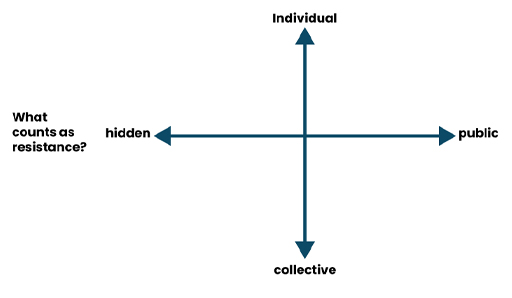1.1 Continuums of resistance
Continuums are useful for interpreting organisational practices because they allow for nuanced thinking and analysis. A continuum is a range of potential practices between two extreme poles.
Resistance is a big concept, so it is helpful to have a framework that can organise your thinking and practice. Mumby et al. (2017) provide such a framework through offering two continuums of resistance. These are:
At one pole, resistance is conducted by a single person, and at the other pole it is something that is only ever conducted by many people simultaneously. Sometimes it is important for resistance to be practised by a single individual, because that individual may have unique insight or opportunity. Sometimes it will be necessary to conduct resistance collectively, because only a group of people will have the abilities, power and expertise to successfully resist. Between these lie various mixes – sometimes resistance is more or less individual or collective, depending on the circumstances.
At one pole, resistance is always hidden from view, and at the other pole it is always conducted in full public view. Sometimes it is necessary to conduct resistance in secrecy, because being open would mean that it would be easy for power to crush it. At other times, it is necessary to conduct resistance openly so that others can gain courage from seeing it, or to intimidate those in power into agreeing to the demands of those resisting. Between extremes lie a range of mixes where sometimes resistance is more or less hidden or public, depending on the circumstances.
None of these options are inherently better than the others, but their dynamics are distinctive. Mumby et al. place these two continuums of resistance together, offering a map, which you can use to plot various forms of resistance that you notice around you. This allows you to note whether the resistance you see demonstrates more or less individual–collective and public–hidden qualities.
Resistance can vary greatly depending on context, the aims of the resisters and the power dynamics in play. Depending on the situation, certain kinds of resistance can be more effective than others. The most ineffective forms are those that are easily deflected or even absorbed into the dominant power, whereas more effective forms of resistance prompt an alteration of power dynamics.
Activity 1 Resistance continuums in your experience?
Can you think of any examples, either from your own experience or in the world at large, of these continuums of resistance in action? How effective do you think the resistance was in each case? Make some notes about your thoughts.
Comment
There are no right or wrong answers to the question of which end of a continuum is more effective. Much depends on the context in which the resistance takes place. For example, under conditions of surveillance and even danger, it makes sense to resist in hidden ways. Resistance can also be fluid, migrating from one end of a continuum to the other as circumstances change.



